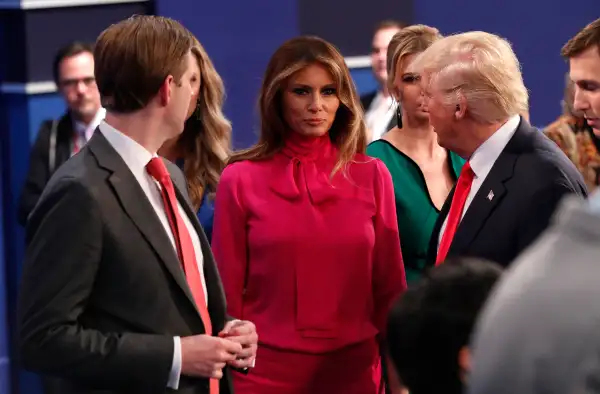14 Memorable Money Moments in American Political Fashion
- What Hillary Clinton's Loss Means for Working Women
- 10 Role Models For Bill Clinton If He Becomes 'First Gentleman'
- An Artist Mints Her Own Take on Bitcoin
- The Woman Who Followed Her Identity Thief for Two Years
- James Damore Apologized For Saying Women Have More 'Neuroticism.' Except, He Really Didn't.

As a politician (or the wife of one), it is hard to avoid having nearly every aspect of your appearance publicly torn apart, and any mistake can be costly. Just witness the recent brouhaha over Melania Trump's silk crepe de chine shirt or Hillary Clinton's choice of jacket.
Such outrage over fashion statements has always been with us, from Mary Todd Lincoln's 400 pairs of gloves to John Edwards's $1,000 haircuts. Sometimes, though, a sartorial choice has the opposite effect, helping a politician communicate a "man of the people" message that belies his (or her) personal wealth.
During this dramatic debate season, Money offers this compilation of some of the most memorable money moments in political fashion.
Melania Trump's $1,100 Subtweet
Just days after The Washington Post released a lewd hot mic recording of her husband boasting that his fame allowed him to “do anything” to women (including grabbing their genitals), Melania Trump caused a media firestorm of her own by wearing a $1,100 Gucci “Pussy Bow” shirt to his second presidential debate against Hillary Clinton. Reportedly, a campaign spokesperson said this was "unintentional", but many in the fashion world still questioned whether her expensive choice of attire was intended as a joke or a silent comment reinforcing her statement that Donald’s comments were “unacceptable” and “offensive" even if she was accepting his “apology."
Hillary Clinton Makes a (Fashion) Statement About Inequality
On April 19, 2016, the internet exploded after Hillary Clinton defeated Bernie Sanders in the New York Democratic primary. But it wasn't due to the significance of the win; instead, the fabric of social media ripped at the seams over Clinton's choice of attire—a Giorgio Armani jacket priced at $12,495. While Clinton is no stranger to criticism of her appearance, she took particular heat for wearing the jacket to give a speech on inequality that night.
Donald Trump’s Cuffs Reveal Bluffing Hands
Republican presidential candidate Donald Trump had a lot up his $7,000 Brioni suit sleeves when he passed out “diamond cufflinks” as presents to friends and colleagues. Reportedly telling Charlie Sheen the ones he gave him were genuine Harry Winston and telling his mentor, lawyer Roy Cohn, his were Bulgari, he in fact handed out cubic zirconia cufflinks (originally thought to be worth tens of thousands) that a source told the New York Post were valued at less than $100.
Ann Romney’s T-Shirt Gets a Dressing-Down
Is it a fish? Is it a bird? Who cares, it’s a $990 T-shirt! Ann Romney’s Reed Krakoff Audubon silk top, which she wore on CBS’s “This Morning” in 2012 while the country was still in the midst of a recession, was held up in the Washington Post as "indicative of a tone-deaf campaign." (And lest anyone think it was a gift from the designer, Krakoff was quick to point out that the candidate's wife bought it off the rack.)
Michelle Obama Puts an Expensive Foot Forward
In May 2009, Michelle Obama sported some comfy sneakers, in anticipation of a day spent on her feet assembling food packages for hungry children at the Capital Area Food Bank. What she failed to do was check the pricetag before she left the White House, since her kicks were quickly ID’d by the media as Lanvin cap toe sneakers priced around $550 at Barneys.
George W. Bush Wears a Cheap Wristwatch With His Custom Suits
As the son of the 41st president of the United States and grandson of Wall Street banker and Sen. Prescott S. Bush, President George W. Bush struggled to overcome his reputation as being out of touch with the general populace. His custom suits from Giliberto Designs, Oxxford and Sam’s Tailor, costing thousands of dollars each, did little to contradict his rich image. In an attempt to offset their extravagance, he donned a $50 Timex Indiglo quartz wristwatch. But not just any drugstore Timex: his was customized with the presidential seal and engraved.
John Edwards Pays Dearly for His Coif
Presidential candidate and "pretty boy" Edwards faced heavy criticism in 2007 when it was reported that he paid $1,250 for a haircut—including covering travel expenses—for his Beverly Hills stylist Joseph Torrenueva. The shear expense seemed astronomical to anyone listening to his political platform, which centered around issues of poverty. (He subsequently started getting his 'dos at Supercuts, according to the New York Post.) It is worth noting, however, that an Edwards cut still ranks quite cheap internationally when compared with the $10,958 monthly salary paid to the stylist who tends to French President Francois Hollande's locks.)
Sarah Palin Goes on an RNC Shopping Spree
After Alaska Gov. Sarah Palin, the quintessential outdoorsy sports mom, became the Republican vice presidential nominee on August 29, 2008, the Republican National Committee decided to outfit her and her family with more refined wardrobes. The $150,000 shopping expedition was widely criticized—especially at a time when the country was in an economic crisis. Republication political consultant Ed Rollins told the New York Times, "It looks like nobody with a political antenna was working on this. It just undercuts Palin’s whole image as a hockey mom, a ‘one-of-us’ kind of candidate.” Initially, Palin herself went into sticker shock. However, it didn't take long before she became quite comfortable in her pricey new threads.
Adlai E. Stevenson’s Holey Shoes Are a Step in the Right Direction
As the grandson of a vice president and a solid member of the upper crust, Democratic presidential contender and Illinois Gov. Adlai Stevenson was having a hard time painting himself as a “candidate of the people.” However, after a photograph of him wearing shoes with holes in the soles at a 1952 Labor Day speech surfaced in the paper—and was adopted by his campaign—he became a symbol of frugality with which the public could better identify.
President 'Jimmy Cardigan' Stays Warm by Layering
April 18, 1977, was a chilly day in the neighborhood for President Jimmy Carter. In a televised “fireside chat,” Carter advocated energy conservation and announced a tax increase on gas and heating oil. His not-so-subtle wardrobe choice of a cardigan suggested that he had lowered the White House thermostat to conserve fuel. He hoped to set an example for American public, but the unintended effect was an irritated audience.
John McCain Missteps in Italian Imports
John McCain was wrong-footed on the 2008 campaign trail, when he traveled the country to discuss the housing crisis facing Americans—and did so in $520 imported Ferragamo calfskin loafers. As the owner of a ranch in Sedona; condos in Phoenix, Arlington, and La Jolla; and two beachfront residences in California, according to the Atlantic, McCain raised hackles among voters who felt he couldn't relate to their struggles to pay their mortgages.
George Washington Styled Himself With Scarce Resources
President George Washington's hair—an arrangement known as the "queue" that was all the rage in the 18th century—was not a wig. Instead, it involved laborious styling of his past-the-shoulders hair, first pulling it back to show off his forehead, then braiding and tying it, fluffing the sides, and finally powdering it to a white sheen. Washington's powder recipe included grease and flour—even though at the time, flour was rationed for his own Continental Army troops to "two pounds of flour and one-half pound of rendered tallow per hundred men."
Nancy Reagan Gets the Royal Treatment
Nancy Reagan's 1981 inaugural gown gave the country sticker shock in its day. Priced at $10,000 (and part of her $25,000 inaugural wardrobe), the dress appeared to elevate Mrs. Reagan to the status of royalty, judging from the photographs she posed for in the East Wing of the White House. The New York Times reported, "Nancy Reagan has, in her first nine months in the White House, become identified with spending money." Beyond the dress, Reagan also purchased more than $200,000 of new china for presidential residence and refurbished it using $800,000 of donations from affluent friends. The "Queen Nancy" moniker stuck—so much so that the first lady herself famously poked fun at it at a 1982 journalists' dinner.
Mary Lincoln Sure Could Shop
If Nancy Reagan's White House expenditures seem excessive, they pale in comparison with First Lady Mary Lincoln's. Known for her struggle with emotional instability (she was institutionalized in her later years), Mary Todd Lincoln also had a reputation for being a shopaholic. According to the Lehrman Institute, "One memorable four-month period saw her collect about 400 pairs of gloves," and "At A. T. Stewart’s New York department store, she bought furs, silks laces, jewelry, three thousand dollars for earrings and a pin; five thousand for a shawl." As if her personal expenditures weren't enough, she also headed an extravagant redecoration project of The White House (far exceeding the $20,000 had been allotted), which infuriated her husband. "It never can have my approval," the president declared. "It would stink in the nostrils of the American people to have it said that the President of the United States had approved a bill overrunning an appropriation of $20,000 for flub-dubs for this damned old house when the soldiers cannot have blankets."
